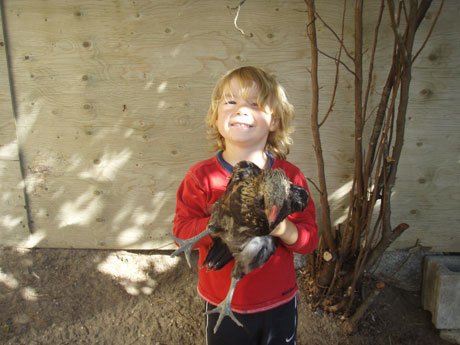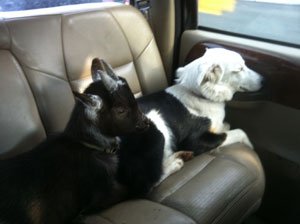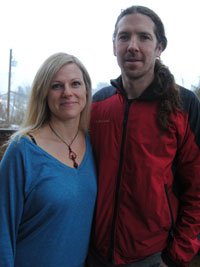
By Gagandeep Ghuman
Published: Jan. 28, 2012.
They have already lost their goat to it, but the Willmot family is defiant about not losing their chickens to Bylaw No. 2053.

We are going to fight it, they say.
Mark and Brandy Willmot live on Clark Drive home with their four kids, a dog named Skye, and a cat named Billy.
They had other ‘pets’: A pygmie goat named Elliot, and four chickens named Weesey, Maloona, Sunny, and Jobe.
The bylaw officers thought otherwise.
For them, Elliott was livestock, and so were the four chickens Willmot family had in their home.
The bylaw considers the animals wildife attractants, and they are allowed only in areas zoned for agriculture.
So, just before Christmas, the family alleges, bylaw officers sneaked into their backyard, saw Elliott with the dog, and took the dog away, after a neighbour took the goat to protect it .
The neighbour called Mark Willmot, a teacher at Howe Sound Secondary Schol, who rushed to the spot.
They received a letter next day, asking them to remove the chickens and the goat by January 26, as they had disobeyed the bylaw.
“Failure to comply with the removal of the chickens and the goat may result in a fine of $200 per day for each day of non-compliance.”

“We had him neutered, and he was not being raised for milk or for meat. So, how can Elliott be considered livestock?,” asks an upset Brandy Willmot.
It’s an open secret that, despite a bylaw prohibition, people keep livestock on their property, some out of defiance, and some out of the belief that the bylaw fails to reflect the zeitgeist of sustainable living, of consuming food grown closer to home.
Brandy and Mark kept the chickens and goat because they were cute pets, but also because they had heard the Squamish council was soon going to review the bylaw.
For now, they have sent the goat to its original owner in Squamish Valley, but they are adamant about keeping the chicken.
The chickens, Weesey, Maloona, Sunny, and Jobe, were not for meat, or for breeding, the Willmots say.
“We only want to collect a few eggs and educate our children,” Brandy said.
The chickens sleep in a secure structure at night, and are in a penned area during the day, she added.
“Also, we no longer use our compost as our chickens eat veggie scraps, and this eliminates the use of compost, which is also considered a bear attractant,” she said.
The Willmot family vows to fight the bylaw, even if they end up paying the fine.
“We will write to our councillors and Mayor first and then find out what the next step could be,” Brandy said.
They have some sympathetic ears there.
At a committee of the whole meeting on Tuesday, Jan. 25, the matter was raised as part of discussion surrounding the food charter proposed by Squamish CAN.
“I want backyard hens,” said Coun. Bryan Raiser, as he grilled Cameron Chalmers about a pilot project that would allow backyard hens on a trial basis for a year.
Chalmers said a revision would mean change in several related bylaws, but Coun. Susan Chapelle said that is not true.
“We need to change only one bylaw,” she said.
Chapelle, too, is part of the HIMBY crowd.
“We don’t ban dogs and cats, then why ban chickens,” she said.
Coun. Doug Race, however, isn’t in favour of a trial, saying even one year of legalising backyard hens “may be too much.”
He said Squamish has ‘invested heavily’ in Bear Smart and other initiatives.
“I am mainly concerned by the possible effects of putting wildlife attractants into our residential neighbourhoods,” he said.
This isn’t the first– and it certainly won’t be the last– time bylaw officers will write out fines for breaking the bylaw on keeping livestock on residential property.
The Squamish Reporter had highlighted a few months ago the case of Pam Isbell, who had written a letter to the district, asking to let her keep her ageing hens as pets.
The district refused that request.
In 2005, the District of Squamish became one of the first municipalities in the province to implement a Wildlife Attractant Bylaw. In October last year, the council passed a motion to introduce fines upto $500 as an enforcement measure.
Meanwhile, two bylaw officers came to the Willmot house on Jan.27th, but the couple wasn’t home.
“But I know they will be back,” Mark says, wryly.




Tige says
This annoys the hell out of me. Why is the district of Squamish harassing this family over a goat and a chicken. Is this really where district resources are best applied? Surely the bored bylaw officers can find a better use for their time. Leave the Willmott’s alone.
Marty Marquette says
change the by- laws – keeping a few goats – pigeons – chickens – pot belly pig that are kept in a clean protected back yard is Right of a home owner or a tenant who has the permission of the home owner. If people have a Right to kill an unborn child – they should have the right to have a couple of pets – don’t you think.
Carolyn Morris says
Food security in Squamish is dangerously fragile. We don’t have enough local farms to feed us and we rely, almost entirely, on imported food. Squamish residence are gradually awakening and taking a step in the right direction. Backyard gardens are growing and locals are taking the effort to support the developing local food economy. The city needs to support this movement, not suppress it. Backyard layers, if cared for and housed appropriately, are a fantastic addition to a home, providing food, education, compost… and a step closer to food security. Perhaps there is a future for goats in Squamish… but without a doubt, backyards have a place in the present!!
Mark Nesbitt says
Hands off the goat and chickens NOW ! We need to introduce sustainable agri-practices and it’s crucial we allow for backyard chickens. Carry on the fight, Willmots !
Nate Dolha says
This bylaw really needs to be modernized; keeping a few hens should not present any issues with bears if they are kept properly. There are great designs available for secure coops and runs, and some thoughtful regulation should mitigate any conflicts.
Don Patrick says
Where are these idea’s coming from…. I was brought up in a cave and chickens, goats, pigs, ducks, geese were part of the family… but we had no neighbours to smell the by-products nor did we have to worry about decease and molting chickens, horny fighting animals because the occupied land was hugh and they would just be eliminated humainly… so putting this is into perspective, please do not become my neighbour if you have a miniture barn yard… it ain’t what you think it is and owning farm animals in a organized municipality is not a right, maybe a priviledge, but not a right. Thinking like a person in a tent city. The idea is to advance society, not back it up…. with population growth what it is today, we only have so much time to have fun. Cheers DP
Anonymous says
If only we could rely on the residents to properly take care of there backyard livestock ie.chickens, goats, etc…where would you like the district to house these animals when they become “at large” in the community, who will enforce the containment etc. of these animals the bored bylaw officers (as I believe above comment states?) Will the district bring on more staff and bulid a facility to take on the now issue of “livestock”?? Think about it folks, the dog pound is always bursting with animals as is the cat shelter do you think that is the bylaw officers fault or the communities?? I say the communites….as nice as it sounds I am NOT in favor of allowing chickens, goats, etc in residential neighborhoods there will always be bad apples in the bunch that will have depolable animal husbandry practices, and I think it is just a BAD idea. keep it on the FARM~!!!!!!!you want these things in your “back yard” MOVE to a FARM!!! HELLLO
ted prior says
Good points We have a wildlife Attractant bylaw are Barbeques on there
4 chickens verses compost ??
goat verses dog [ dog sh-t ] every where
Bylaws are a complicated thing and take lots of time to change
I would like to see the complaints that required bylaw to attend
I say pull the bylaw until council has a chance to review
David says
I recently discovered that someone up the street has chickens. I was walking by and it smelt that something had died there. The smell was coming from the chicken yard. My tenants in Kamloops keep a bunny for a pet. No problem. A tenant in the same complex is causing problems because the front and back of his unit is covered in dog excrement. We don’t have a problem with feral cats or dogs in Squamish because we also have coyotes and cougars. Conclusion? It is not the species of pet, but rather the type of owner that causes problems for the neighbourhood, but there are always idiots who will abuse rights and privileges. The district should keep the bylaw.
Jill says
You say there are a few idiots out there who will not look after their animals properly and cause problems in the neighbourhood. Your solution is to keep the bylaws in place so no one is allowed to keep livestock in their backyard.
I don’t see how that is different from saying there are irresponsible dog owners, so no one should be allowed to keep a dog, or there are bad drivers out there, so no one should be allowed to operate their own vehicle.
I think a better idea would be to revise the bylaw to allow certain types of livestock in urban areas with very precise guidelines. Licences should be required (like a dog licence – the costs of additional bylaw enforcement overhead need to be covered). There should be zero tolerance for bad animal husbandry, and the licence to keep livestock should be revoked (and ability to re-apply curtailed for some time) if guidelines are not being met.
I think a trial period is a good idea. The community (and applicable experts ie: bear aware rep) should be allowed to input ideas on what the precise guidelines for the “chicken (or livestock) licences” should be (with revisions ongoing throughout the trial).
David says
I kind of agree with your argument, and there are other points that could be made. For example, I am going to have to stop feeding birds in my backyard because the feed that falls to the ground is attractive to rats. I have a holly tree and a mountain ash that drop berries that I suppose I’m supposed to pick up. All of these things are illegal under the bylaw. I wonder if people who are keeping horses and cows on rural properties are required to pick up the droppings and make sure the animals are in a secure shelter overnight. I wonder if the District is going to obey its own bylaws and hire people to go around removing any blackberries, crabapples, mountain ash berries, etc. that might occur on parklands or other crown lands. Perhaps they will choose to have the bylaw officers issue tickets to the District and then we’ll have to pay the fines out of our taxes.
Nate Dolha says
@Jill, I think you are bang on in your assessment – The trial would give the municipality and the enthusiasts work through any issues and draft comprehensive regulation. The argument about the potential for problems is a non starter, and if we drafted all regulations with the ‘bad apple’ lens we wouldn’t be permitted to do much in our lives…
There are many examples of (larger) municipalities who have gone down this road, and should provide a good starting place for a successful trial and program here – all we are missing is a change in conversation!
Stéphane says
There is no doubt that bears are attracted to chickens. I hear a story or two every summer in Brackendale. Electrical fencing is extremely efficient at negative conditioning bears. Electrical fencing is safe and the district should allow it their bylaw as a legitimate way to keep bears away from chickens..
Elliot says
@ David and Jill on the policing model; As long as the chicken permit license fees are high enough to cover the added costs of bylaw policing and SPCA etc, so that the community isn’t bearing a net new burden on tax revenue, then I would vote yes in a referendum. Permits should only be available for lot sizes of a certain minimum, say 10,000 sq.ft.; and coops a minimum distance from neighbouring structures. Smell is an issue. @Stephane; Curious, are electric fences safe for children?
Carolyn Morris makes a very strong point about local food supply, however this doesn’t necessarily support residents in single family neighbourhoods becoming livestock farmers. Pemberton beef is a local food supply for example. So, just like there are co-op community gardens, there could also be a co-op community chicken farm in a suitable farm location where you can keep your own hens. Also, I love goats but they are naturally a nuisance and only fair for them to be in a large land area to do their thing; a typical single family home lot is definitely not big enough, I know from experience.
Stéphane Perron says
Yes, totally safe. Whistler and Blackcomb mountains have electric bear fencing right by tourist areas without any concerns for human safety.
Christine Elliott says
We had up to 30 chickens who free ranged during the day on a half acre lot and had a coop with a fenced area for night. Living right on the edge of wilderness in Haida Gwaii where there is a large Black Bear population, we NEVER saw a Bear in our yard over 5 years, until we got pigs.
Albert says
The Wildlife Attractant Bylaw does not in fact prohibit chickens, or mention livestock at all.
It also does not prohibit things that can be wildlife attractants, like barbeques, garbage, compost, bird feeders, antifreeze and grease. It regulates how they must be managed and stored, and if they do attract wildlife it’s a problem. Under the bylaw, fruit can lay on the ground for up to three days before it’s a problem! Slow bears I guess.
The District doesn’t pursue people who put their garbage out the night before week after week, even though they are stickered repeatedly, but they’re on a mission against chickens and goats?
Our Council should instruct the bylaw officers to cease and decist, unless there’s an actual animal attractant problem – then deal with it as such.